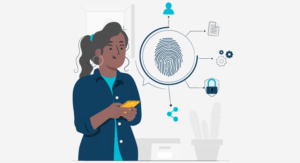5 Trends that Ensure Digital Identity Verification is Crucial in Digital Age

Organizations have been making their switch to digital services for a long time, the pandemic brought a drastic change in the trend. One common change is how we access our financial services online. As most people are looking forward to returning their lives to the pre-pandemic era, digital channels and services are necessary. It is evident that the financial services industry and consumers and businesses alike must now open bank accounts, apply for loans and make payments using online and banking channels.
To make the remote banking processes successful, banks and financial industries need a high level of trust between digital services and consumers. Banks interacting with new and old customers need to verify who the customers are they are in a relationship. Financial industries need to follow through with the KYC (Know-Your-Customer) processes. The compliance has to be met with the local regulations and financial industry’s regulations. KYC verification is the process of verifying an individual’s identity online or in real-time during the customer onboarding process. Here are some of the most common digital identity verification trends that show that digital identity verification is vital in the digital age.
Trend 1: Digital ID Verification Offers Incredible Incentives
Since the rise of technology, Identity verification has always been a key focus for businesses that need to comply with KYC regulations and reduces the risk of application fraud. Typically, ID verification happens when a customer offers a valid ID document during the onboarding process. Financial institutions have switched to digital ID verification to complete the remote onboarding process securely. It is the first digital identity verification trend that enables online ID verification.
Since the pandemic hit the world, the investments made in digital account opening have doubled globally. So the desire to digitize has always existed, though strict changes had never been made.
While the basic needs for digitization remain the same, financial institutions now have a much higher need for digital services. Before the pandemic, a lot of Financial Institutions had partially designed digital ID verification methods.
Trend 2: Enabling Digital Identity Verification Requires Secure and Compliance Regulations
Financial services customers have to be able to open an account or access their banking services, but they also want to feel reassured that they have an ideal level of security to protect customer data. Any service that banks and financial institutions choose will have to ensure the solutions contain security, anti-fraud, data privacy, and compliance requirements.
When choosing the Digital ID verification solutions, the following requirements have to be met:
- Cross-channel ID verification
- Does the solution support document ID in countries, states, and provinces that you want to target.
- Quality Assurance and Due Diligence.
- Elimination of paper processes and manual verification.
- Infrastructure, device, and app security
Not all digital ID verification methods are built equal, and different solutions offer different verification results. Solutions like DIRO’s online document verification verifies online documents instantly for verifying customer data. This reduces friction and improves customer onboarding processes.
Trend 3: Financial Institutions with Already Enabled Digital ID Offers Better Experience
It is obvious that financial institutions that already have perfect digital ID verification solutions are set up to provide a seamless remote customer onboarding process.
Banks and financial institutions that have a proper digital onboarding channel will definitely onboard more customers as opposed to institutions that don’t have the right digital ID solutions. Banks and other institutions need to pick up the pace to set up ideal solutions in place. Covid-19 has exposed the shortcomings of digital banking services and it has created an urgent need for them to put the right solutions in place.
Trend 4: Digital Identities Will Become More Common In Various Industries
Not just financial institutions, but other industries also need to verify identities. Governments and healthcare providers are trying hard to set up digital identity solutions to reduce the rate of fraud. In the US, The Coronavirus Aid, Relief, and Economic Security Act allocated $349B in aid to small businesses as a part of the Paycheck protection program. It utilized e-signature technology, which enabled its clients to access relief funds easily and securely while protecting the lenders from fraud.
In the digital age, there is a constant need for individuals and businesses to access crucial financial relief quickly and without the need for face-to-face interactions. Governments and healthcare institutions are expected to set up solutions that can support the needs of the customers.
Trend 5: The Pandemic Has Seen a Dramatic Rise in Volume of Online Transactions
Since most people have switched to online services after the pandemic, there has been a huge rise in the overall volume of online and cashless transactions. A variety of fraudsters are taking advantage of the chaos and lack of ideal security solutions to increase the number of frauds.
There are reports that in the unsecured lending space, both banks and FinTech lenders saw a huge surge in lending fraud when COVID-19 was declared a pandemic. Almost all kinds of frauds were done, such as first-party application fraud, third-party application fraud, and synthetic ID fraud. Financial institutions onboarding remote customers need to be vigilant in their onboarding and online ID verification methods. This is needed to reduce phishing scams and fake websites. This is the last digital identity verification trend that suggests the need for digital ID verification.
Conclusion: Digital Identity Verification Trends
The rules and customer behaviors have changed over time. Companies that can fully digitize their account opening, loan application, and financial product sign-up processes are sure to improve the customer base and a frictionless customer onboarding process. As fraud attacks are ever-increasing, there is a high need of establishing trust between remote consumers and financial institutions becoming more important.












